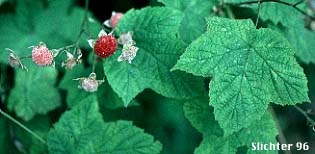Thimbleberry as seen along forest service road #7300-400, Wenatchee National Forest........June 8, 2009.
Thimbleberry as seen along forest service road #7300-400, Wenatchee National Forest........June 8, 2009.
Thimbleberry is an attractive, upright shrub from 0.5-2.5 meters in height. The stems have a dull brown, shedding bark, and unlike other members of the genus, they lack stickers. The large, simple leaves with palmate venation are alternate on the stems. The margins have 5 lobes cut up to 1/3 of the way into the leaf. The margins are also toothed. The leaves vary from 6-15 cm in length, and tend to be somewhat wider than long. The leaves are covered with short hairs which give them a soft, felt-like texture.
The large flowers are up to 2.5 cm across, with 5 white (occasionally pink-tinged) petals which are oblong-obovate to obovate in shape and may be up to 30 mm long. The pistils and stamens are numerous. The scarlet fruits are fleshy berries with many seeds which separate from their pith in a thimble or hemispherical shape.
The thimble-like fruits are like soft, fuzzy raspberries, and are often eaten by campers. Songbirds, upland gamebirds, and many mammals also eat the fruits. The leaves and twigs are grazed by browsers such as deer. The leaves are an excellent forest toilet paper. Thimbleberry is often found in thickets where it provides excellent protection and nesting for birds.
Thimbleberries may be planted for use in the wild home garden. It is an excellent plant for use along fences or to block the view into neighbor's yards. Be aware however, that it spreads easily via its underground rhizomes, and can thus spread where it isn't desired.

Thimbleberry may be found on open moist or dry sites. It is commonly found along roadsides, on logged slopes, along the edges of forests, and along streams. It may be found from the Pacific coast to subalpine habitats in the mountains.
Thimbleberry may be found from Alaska south to southern California and east to the Great Lakes.